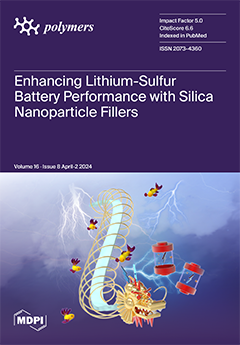Natural and synthetic polymers are a versatile platform for developing biomaterials in the biomedical and environmental fields. Natural polymers are organic compounds that are found in nature. The most common natural polymers include polysaccharides, such as alginate, hyaluronic acid, and starch, proteins, e.g.,
[...] Read more.
Natural and synthetic polymers are a versatile platform for developing biomaterials in the biomedical and environmental fields. Natural polymers are organic compounds that are found in nature. The most common natural polymers include polysaccharides, such as alginate, hyaluronic acid, and starch, proteins, e.g., collagen, silk, and fibrin, and bacterial polyesters. Natural polymers have already been applied in numerous sectors, such as carriers for drug delivery, tissue engineering, stem cell morphogenesis, wound healing, regenerative medicine, food packaging, etc. Various synthetic polymers, including poly(lactic acid), poly(acrylic acid), poly(vinyl alcohol), polyethylene glycol, etc., are biocompatible and biodegradable; therefore, they are studied and applied in controlled drug release systems, nano-carriers, tissue engineering, dispersion of bacterial biofilms, gene delivery systems, bio-ink in 3D-printing, textiles in medicine, agriculture, heavy metals removal, and food packaging. In the following review, recent advancements in polymer chemistry, which enable the imparting of specific biomedical functions of polymers, will be discussed in detail, including antiviral, anticancer, and antimicrobial activities. This work contains the authors’ experimental contributions to biomedical and environmental polymer applications. This review is a vast overview of natural and synthetic polymers used in biomedical and environmental fields, polymer synthesis, and isolation methods, critically assessessing their advantages, limitations, and prospects.
Full article






